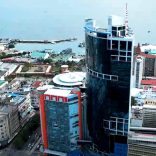Mozambique limits beverage alcohol to agricultural ethanol only - Watch
IGEPE says assets of Emose, Correios, Stema and Domus are worth more than 7 billion meticais – Carta

FILE - illustrative photo. Emose building in Maputo's Baixa. [File photo: Noticias]
In March, the government’s State Participation Management Institute (IGEPE) announced its intention to restructure four public companies: Empresa Moçambicana de Seguros (EMOSE), Correios de Moçambique, Sociedade de Gestão Imobiliária (Domus) and Silos Terminal Graneleiro da Matola (STEMA).
Speaking at a virtual event about the restructuring organised by the Centre for Public Integrity (CIP) on Friday (14-05), IGEPE executive director Raimundo Matule said that the IGEPE values the companies’ assets at 7 billion meticais.
The amount is obtained by dividing the net asset value by the number of shares in the companies, and not those in the market (the result of multiplying the current share price of a company by the number of existing shares) .
The IGEPE executive director underlined that the 7 billion meticais is not the market value, which is to be established by Intellica, the company assisting the government in the reform of those companies, and whose work is costing the IGEPE around 33 million meticais.
“We are talking about assets valued at more than 7 billion meticais, book value. The market price that we obtain will probably be twice the book value of the assets that we are placing on the market,” Matule said.
With studies still in progress, the IGEPE administrator would not advance the amount money that the state expects to get from the total or partial sale of the four companies’ assets.
“I cannot give a number for the values that we will receive, because we are waiting for the valuation at market prices of the assets that we are placing on the market,” Matule said.
A CIP analysis released at the event and based on data provided by IGEPE, reveals that the government intends to reform the Correios de Moçambique because its “business object and model are outdated”. The company had been unable to adjust to the environment and should therefore be “transformed from a public company to a public limited company and divest part of its assets to the private sector in order to obtain a financial contribution for the state”.
The company is in financial difficulties and unable to finance the costs of its operation. The government had been obliged to inject 64 million meticais to pay the wages of the company’s 500-plus workers.
According to the CIP study, in the case of Domus, the IGEPE maintains that “it is not efficient for the state to compete as a reference shareholder with the private sector in a very dynamic and competitive market, and [it] therefore intends to dispose of its participation in the totality”.
Regarding STEMA, CIP quotes the IGEPE as explaining that the company “is neither strategic nor structuring”. The institution claims that STEMA needs to carry out major modernization investments to restore the operational capacity damaged by a fire that occurred a few years ago, and that the state should reduce its participation in the company by divesting a part of it to the private sector in order to thereby obtain some dividend.
As for EMOSE, the IGEPE’s explanation to the CIP also states that the insurer is neither strategic nor structuring, and therefor does not fit into the country’s development plan. The IGEPE executive director said that the Emose management experienced a “conflict of interest”, since it was both regulator of, and majority shareholder in, the enterprise.
By Evaristo Chilingue












Leave a Reply
Be the First to Comment!
You must be logged in to post a comment.
You must be logged in to post a comment.